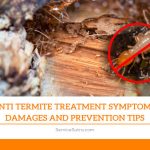Termites, those tiny wood-devouring insects, can create immense damage without homeowners even realizing it. Picture this: You’re planning a home renovation, only to discover that the very foundation you’ve been living on has been slowly eaten away. Not the kind of surprise anyone wants.
The hidden threat posed by termites isn’t merely a nuisance; it’s a potential catastrophe. But fear not, for every problem there’s a solution. Let’s delve into how you can ensure your home remains a safe haven, free from the grip of these pesky intruders.
Understanding the Enemy
Before choosing a treatment, it’s essential to know what you’re up against. Termites live in colonies and feed on cellulose, a primary component of wood. There are different types of termites:
- Subterranean Termites: They live underground and are the most destructive.
- Drywood Termites: They live within the wood they consume.
- Dampwood Termites: Found in wood with high moisture content.
Identifying Signs of Termites
Early detection is key to effective termite control. Here’s what to look out for:
- Mud Tubes: Built by subterranean termites to reach food sources.
- Hollowed or Damaged Wood: Termites consume wood from the inside out, leaving a thin veneer of paint or wood.
- Winged Termites: Usually found near lights, indicating a termite swarm nearby.
- Frass or Termite Droppings: Resembles tiny, wood-colored pellets.
Choosing the Right Treatment
Now that you’re equipped with the basics, let’s look at the solutions available:
- Liquid Termite Barrier: This involves applying a liquid pesticide around the entire perimeter of the home. It not only kills the termites but also prevents them from returning. Ensure you get a professional to apply it for maximum efficiency.
- Termite Baits: These are set up around the perimeter of your house or near active termite sites. Baits contain toxins that termites carry back to their colony, eventually wiping out the entire colony.
- Borate Wood: A treatment for drywood termites, borate is sprayed or brushed onto wood surfaces, poisoning any termite that consumes the wood.
- Fumigation: In cases of severe infestation, tenting the entire structure and filling it with poisonous gas can ensure every termite is exterminated. This method requires temporarily vacating the home.
DIY vs. Professional Treatment
While DIY kits are available, professional treatment is recommended for severe infestations. Here’s why:
- Expertise: Professionals are trained to detect even the most hidden colonies.
- Safety: Handling chemicals requires caution, and professionals come equipped with the right tools and protective gear.
- Effectiveness: With knowledge of termite behavior, professionals can target treatments more effectively.
Prevention: Better Than Cure
While treatments can get rid of termites, prevention is always more cost-effective and less disruptive. Here are some preventive measures:
- Reduce Wood-to-Ground Contact: Ensure that wooden parts of the house, like siding or porches, don’t touch the soil directly.
- Limit Moisture: Termites thrive in damp conditions. Regularly check for leaks and maintain proper drainage.
- Regular Inspections: Get your home inspected annually, especially if you live in a termite-prone area.
Natural Remedies: Mother Nature’s Way of Control
Going the natural route is an eco-friendly alternative to chemical treatments, ideal for homeowners who prioritize sustainability. Here’s a quick overview:
- Nematodes: Beneficial microscopic worms attack termite colonies and have proven effective in reducing their population.
- Diatomaceous Earth: This naturally occurring substance damages the outer layer of termites upon contact, causing dehydration and eventual death.
- Vinegar: A mixture of vinegar and lemon juice sprayed directly on termites can kill them. It’s best for small infestations.
- Cardboard Traps: Termites are attracted to the cellulose in cardboard. Placing wet cardboard near a termite hotspot can lure them out. Once they swarm the cardboard, simply discard it or burn it, ensuring you get rid of the gathered termites.
Using natural remedies can provide a safe and non-toxic method to keep termites at bay. However, for larger infestations, it might be best to combine natural methods with professional treatments for maximum effectiveness.
Conclusion
Every homeowner aspires to offer a safe and cherished environment for their loved ones, and part of that responsibility is ensuring the very foundation of the house remains robust. Termites, although minuscule, have the potential to undermine that stability silently and persistently. Through vigilant observation, proactive measures, and the wise selection of treatment—whether nature-inspired or professionally endorsed—you can shield your home from these unwelcome guests. By taking action, not only do you protect the structural integrity of your dwelling but also the cherished memories within its walls. Embrace the journey of homeownership with knowledge and foresight, ensuring your haven remains termite-free for generations to come.






